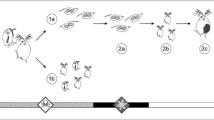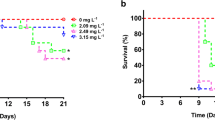Abstract
The effect of the pesticide etofenprox (0.76, 0.95, 1.18, 1.48, and 1.85 μg L−1) on survival, reproduction, and growth of Daphnia magna organisms was monitored using 21-day exposure tests. In order to test pesticide effects on D. magna, survival, length, mean total neonates per female, mean brood size, time to first reproduction, mean number broods per female, cumulative molting, and the population parameter intrinsic rate of natural increase (r) were used. Reproduction was seriously affected by etofenprox. Concentrations of etofenprox higher than 1.18 μg L−1affected all the reproductive parameters analyzed as well as individual length. However, daphnids’ survival after 21 days of pesticide exposure did not exhibited differences among experimental and control groups. The no observed effect concentration (NOEC), the lowest observed effect concentration (LOEC), and the maximum acceptable toxicant concentration (MATC) were calculated for the different parameters. A MATC estimation of 1.32 μg L−1 was calculated for mean brood size, mean number of broods per female, mean number of neonates per female, and the intrinsic rate of growth population. Etofenprox effect on the algae Nannochloris oculata was also evaluated. The selected etofenprox concentrations did not affect algal growth rate (μ) after 24 h; however, N. oculata exposed during 48 and 72 h to the highest etofenprox concentration showed a decreased in its population rate.




Similar content being viewed by others
References
Añasco N, Uno S, Koyama J, Matsuoka T, Kuwuahara N (2010) Assessment of pesticide residues in freshwater areas affected by rice paddy effluents in Southern Japan. Environ Monit Assess 160(1-4):371–383. https://doi.org/10.1007/s10661-008-0701-z
Barry MJ, Meehan BJ (2000) The acute and chronic toxicity of lanthanum to Daphnia carinata. Chemosphere 41:1669–1674
Benli ACK (2014) The influence of etofenprox on narrow clawed crayfish (Astacus leptodactylus Eschscholtz, 1823): acute toxicity and sublethal effects on histology, hemolymph parameters, and total hemocyte counts. Environ Toxicol 30(8):887–894
Birch LC (1948) The intrinsic rate of natural increase of an insect population. Anim Ecol 17:15–26
Bischoff HW, Bold HC (1983) Phycological studies. IV. Some algae from enchanted rock and related algae species. Univ. Texas Publ. 6318, Texas
Blanco-Romero E, Meza Núñez H, Poveda-Calvo V (2005) Metodología para la determinación de plaguicidas organofosforados en leche de consumo nacional mediante cromatografía de gases y extracción en fase sólida. Tecnología en marcha 18(2):103–106
Buhl KJ, Hamilton SJ, Schmulbach JC (1993) Chronic toxicity of the bromoxynil formulation Buctril to Daphnia magna exposed continuously and intermittently. Arch Environ Contam Toxicol 25:152–159
Calow P (1996) General principles and overview. Handbook of ecotoxicology. Blackwell Scientific Public. 478 pp, Oxford
Chang ES, Bruce MJ, Tamone SL (1993) Regulation of crustacean molting: a multihormonal system. Am Zool 33(3):324–329. https://doi.org/10.1093/icb/33.3.324
Daniels RE, Allan JD (1981) Life table evaluation of chronic exposure to a pesticide. Can J Fish Aquat Sci 38(5):485–494. https://doi.org/10.1139/f81-070
Davies R, Zou E (2012) Polybrominated diphenyl ethers disrupt molting in neonatal Daphnia magna. Ecotoxicology 21(5):1371–1380. https://doi.org/10.1007/s10646-012-0891-6
Day K, Kaushik NK (1987) An assessment of the chronic toxicity of synthetic pyretroid, fenvalerate, to Daphnia galeata mendotae, using life tables. Environ Pollut 44(1):13–26. https://doi.org/10.1016/0269-7491(87)90125-4
De Lorenzo ME, De Leon RG (2010) Toxicity of the insecticide etofenprox to three life stages of the grass shrimp, Palaemonetes pugio. Arch Environ Contam Toxicol 58(4):985–990. https://doi.org/10.1007/s00244-010-9496-3
ECHA (European Chemicals Agency) (2012) Committee for Risk Assessment RAC Annex 1 Background document to the Opinion proposing harmonised classification and labelling at EU level of Etofenprox. echa.europa.eu
Ferrando MD, Sancho E, Andreu E (1995) Effects of lindane on Daphnia magna during chronic exposure. J Environ Sci Health B 30(6):815–825. https://doi.org/10.1080/03601239509372967
Ferrando MD, Sancho E, Andreu E (1996) Chronic toxicity of fenitrothion to an algae (Nannochloris oculata), a rotifer (Brachionus calyciflorus) and the cladoceran (Daphnia magna). Ecotoxicol Environ Saf 35(2):112–120. https://doi.org/10.1006/eesa.1996.0090
Huahua S, Baojun Y, Yixi Z, Zhewen L (2017) Metabolic resistance in Nilaparvata lugens to etofenprox, a non-ester pyrethroid insecticide. Pestic Biochem Physiol 136:23–28
Jensen UF, Nachman G, Christoffersen KS (2010) Early signs of lethal effects in Daphnia magna (Branchiopoda, Cladocera) exposed to the insecticide cypermethrin and the fungicide azoxystrobin. Environ Toxicol Chem 29(10):2371–2378. https://doi.org/10.1002/etc.290
Kim Y, Jung J, Oh S, Choi K (2008) Aquatic toxicity of cartap and cypermethrin to different life stages of Daphnia magna and Oryzias latipes. J Environ Sci Health B 43(1):56–64. https://doi.org/10.1080/03601230701735029
Knops M, Altenburger R, Segner H (2001) Alterations of physiological energetics, growth and reproduction of Daphnia magna under toxicant stress. Aquat Toxicol 53(2):79–90. https://doi.org/10.1016/S0166-445X(00)00170-3
Lachaise F, LeRoux A, Hubert M, Lafond R (1993) The molting gland of crustaceans: localization, activity, and endocrine control. J Crust Biol 13:198–234
Lotka AJ (1913) A natural population norm. J Wash Acad Sci 3(241–248):289–293
Mutunga JM, Anderson TD, Craft DT, Gross AD, Swale DR, Tong F, Wong DM, Carlier PR, Bloomquist JR (2015) Carbamate and pyrethroid resistance in the akron strain of Anopheles gambiae. Pestic Biochem Physiol 121:116–121. https://doi.org/10.1016/j.pestbp.2015.03.001
Muyssen BTA, Janssen CR (2001) Multigeneration zinc acclimation and tolerance in Daphnia magna: implications for water-quality guidelines and ecological risk assessment. Environ Toxicol Chem 20(9):2053–2060. https://doi.org/10.1002/etc.5620200926
OECD (2000) Series on testing and assessment 23. Guidance document on aquatic toxicity testing of difficult substances and mixtures. OECD Paris, France
OECD (2004) Section 2 guideline 202. Daphnia sp. Acute immobilization test. OECD Paris, France
OECD (2011) Guidelines for testing of chemicals 201. Freshwater alga and cyanobacteria, growth inhibition test. 28 pp. OECD Paris, France
OECD (2012) Section 2 guidelines for testing of chemicals 211. Daphnia magna reproduction test. 25 pp. OECD Paris, France
Pereira JL, Mendes CD, Gonçalves F (2007) Short- and long-term responses of Daphnia sp. to propanil exposures in distinct food supply scenarios. Ecotoxicol Environ Saf 68(3):386–396. https://doi.org/10.1016/j.ecoenv.2006.10.012
Rajini A, Revathy K, Chitrikha T (2016) Toxicity and reproductive effect of combination pesticide to Daphnia magna. Indian J Sci Technol. https://doi.org/10.17485/ijst/2016/v9i3/766099
Sancho E, Villarroel MJ, Ferrando MD (2016) Assessment of chronic effects of tebuconazole on survival, reproduction and growth of Daphnia magna after different exposure times. Ecotoxicol Environ Saf 124:10–17. https://doi.org/10.1016/j.ecoenv.2015.09.034
Schleier IIIJJ, Peterson RKD (2012) The joint toxicity of type I, II, and nonester pyrethroid insecticides. J Econ Entomol 105(1):85–91. https://doi.org/10.1603/EC11267
Sreehari U, Mittal PK, Razdan RK, Dash AP, Ansari MA (2009) Impact of etofenprox (VectronV R 20 WP) indoor residual spray on malaria transmission. Indian J Med Res 129(5):593–598
Toumi H, Boumaiza M, Millet M, Radetski CM, Felten V, Fouque C, Férard JF (2013) Effects of deltamethrin (pyrethroid insecticide) on growth, reproduction, embryonic development and sex differentiation in two strains of Daphnia magna (Crustacea, Cladocera). Sci Total Environ 458-460:47–53. https://doi.org/10.1016/j.scitotenv.2013.03.085
USEPA (2008) Etofenprox section: environmental fate and ecological risk assessment. PC code: 128965DP bar code: 342966 Memorandum Office of prevention, pesticides, and toxic substances. Washington D.C. MEMORANDUM 20460 June 30. 158 pp
Van Leeuwen CJ, Luttmer WJ, Griffieon PS (1985) The use of cohorts and populations in chronic toxicity studies with Daphnia magna, a cadmium example. Ecotoxicol Environ Saf 9(1):26–23. https://doi.org/10.1016/0147-6513(85)90031-4
Vasquez M, Cahill T, Tjeerdema R (2011) Soil and glass surface photodegradation of etofenprox under simulated california rice growing conditions. J Agric Food Chem 59(14):7874–7881. https://doi.org/10.1021/jf2022572
Villarroel MJ, Sancho E, Ferrando MD, Andreu-Moliner E (2013) Caloric content of Daphnia magna as reflect of propanil stress during a short-term exposure and its relationship to long-term responses. Environ Toxicol Pharmacol 35(3):465–472. https://doi.org/10.1016/j.etap.2013.02.012
WHO World Health Organization (2007) WHO specifications and evaluations for public health pesticides: etofenprox. 29 pp
Yaméogo L, Traor K, Back C, Hougard JM, Calamari D (2001) Risk assessment of etofenprox (vectron) on non-target aquatic fauna compared with other pesticides used as Simulium larvicide in a tropical environment. Chemosphere 42(8):965–974. https://doi.org/10.1016/S0045-6535(00)00172-7
Yurtkuran Z, Saygi Y (2013) Assessment of pesticide residues in Karaboǧaz Lake from Kizihrmak Delta, Turkey. Bull Environ Contam Toxicol 91(2):165–170. https://doi.org/10.1007/s00128-013-1037-0
Zagatto PA (1989) Aspects théoriques et pratiques inhérents a l’homologation des pesticides Vol. 1. Étude comparative de la toxicité chronique du pentachlorophenol vis-à-vis de Daphnia magna et de CerioDaphnia nubia. Centre des Sciences de l’Environnement, Université de Metz, France
Zou E, Fingerman M (1997) Effects of estrogenic xenobiotics on molting of the water flea, Daphnia magna. Ecotoxicol Environ Saf 38(3):281–285. https://doi.org/10.1006/eesa.1997.1589
Acknowledgements
The authors wish to thank the Agrarian Laboratory of Generalitat Valenciana for their help in the analysis of etofenprox concentrations in water samples.
Author information
Authors and Affiliations
Corresponding author
Ethics declarations
Conflict of interest
The authors declare that they have not conflict of interest.
Additional information
Responsible editor: Cinta Porte
Rights and permissions
About this article
Cite this article
Sancho, E., Banegas, S., Villarroel, M.J. et al. Impaired reproduction and individual growth of the water flea Daphnia magna as consequence of exposure to the non-ester pyrethroid etofenprox. Environ Sci Pollut Res 25, 6209–6217 (2018). https://doi.org/10.1007/s11356-017-0952-8
Received:
Accepted:
Published:
Issue Date:
DOI: https://doi.org/10.1007/s11356-017-0952-8




